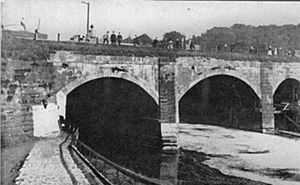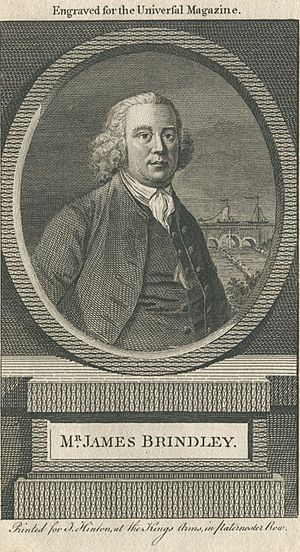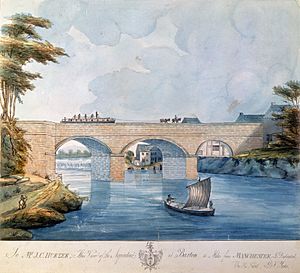Barton Aqueduct facts for kids
The Barton Aqueduct was a special bridge built in England. It opened on 17 July 1761. This bridge carried the Bridgewater Canal over the River Irwell at Barton upon Irwell.
It was the first bridge in England that allowed boats to travel over another river. People called it "one of the seven wonders of the canal age." A clever engineer named James Brindley designed most of it.
Building the aqueduct happened very quickly. But there was a problem when they first filled it with water. One of its three arches started to bend. Workers fixed it over several months. The aqueduct still opened only 15 months after the special law was passed.
It was used for over 100 years. Then, a new, much bigger canal was built. This was the Manchester Ship Canal. Because of this, the Barton Aqueduct had to be taken down in 1893. The Barton Swing Aqueduct replaced it.
Why the Aqueduct Was Built
The first plan for the Bridgewater Canal was to reach Salford. It would stay on the north side of the River Irwell. Work started in 1759.
Soon, they changed the plan. They decided to build a stone aqueduct. This would carry the canal over the Irwell at Barton upon Irwell. The canal would then end in Manchester. A new law was needed for this change.
James Brindley was a very talented engineer. But he didn't have much formal education. He rarely drew his designs on paper. When asked about his plans, he used simple ways to explain.
Once, he showed how to make a watertight seal using clay. He formed the clay into a trough. He explained how it would hold water if worked properly. He said, "Thus it is that I form a watertight-trunk to carry water over rivers and valleys."
Another time, he was asked for a drawing of his bridge. He bought a large round of Cheshire cheese. He cut it in half. He used the cheese halves to show the arches. Then, he put a long object over them. This showed the river flowing under and the canal flowing over. The committee found this very amusing.
Building a canal over a river was a new idea in England. Other engineers thought it was impossible. One engineer said, "I have often heard of castles in the air, but never before saw where one was to be erected."
The law for the aqueduct was passed in March 1760. It was very specific about how the aqueduct should look. This was to protect the Mersey and Irwell Navigation below. There was already a three-arch road bridge there. The aqueduct had to have the same number of arches. Its arches also had to be as wide and high as the road bridge's.
How It Was Built
The aqueduct was about 200 yards (183 metres) long. It was 12 yards (11 metres) wide. At its highest point, it was 39 feet (12 metres) above the river. For its time, it was a huge building project.
The arches were made of many layers of brickwork. Stone was used for decorative parts. All the stone used was carefully cut and laid.
When the aqueduct was first tested, water flowed in. But one of the arches started to bend under the weight. Brindley was very worried. He went to bed at a nearby inn.
Another person, Gilbert, realized the problem. Brindley had put too much weight on the sides of the arch. Gilbert removed the clay. He then put down layers of straw and fresh clay. When the water flowed in again, the arch held firm.
The arch still had a slightly uneven curve. But it became stable after the mortar set.
How It Was Used
The aqueduct opened for boats on 17 July 1761. This was only 15 months after the law was passed. The duke's barges soon used it to carry coal. They moved coal from his mines at Worsley to Manchester.
People greatly admired the aqueduct. Writers at the time often talked about the amazing sight. Crowds came from all over the country to see it.
Those who saw it were often impressed. They saw how easy it was to move boats on the still water of the canal. Below, on the river, ten or twelve men struggled to pull one barge against the current. But 40 feet (12 metres) above, a horse or two men could pull several barges easily.
The aqueduct was 12 yards (11 metres) wide overall. But the waterway for boats was only half that width. The canal was built for boats that were about 14 feet (4.3 metres) wide. This meant two boats could not pass each other.
So, a signalling system was put in place. It controlled access to the aqueduct. A tall pole in the middle of the arch held a semaphore system. It had two arms on each side. Levers on the ground operated these arms.
The aqueduct was used for over 100 years. It was a very important structure. Author Samuel Smiles said it was the "parent of the magnificent aqueducts" built later.
Why It Was Replaced
The Barton Aqueduct had to be removed because of the Manchester Ship Canal. A law was passed in 1885 for this new canal. It would be big enough for ocean-going ships. It would connect the River Mersey estuary to Manchester.
The arches of the old aqueduct were too small for large ships. So, it was taken down in 1893. The Barton Swing Aqueduct replaced it. This new aqueduct is still used today.
The old aqueduct was built so strongly. Workers even had to use dynamite to help demolish it. Some of the stone from Brindley's aqueduct is still preserved. You can see it in the nearby Barton Memorial Arch. This monument remembers his "castle in the air."




